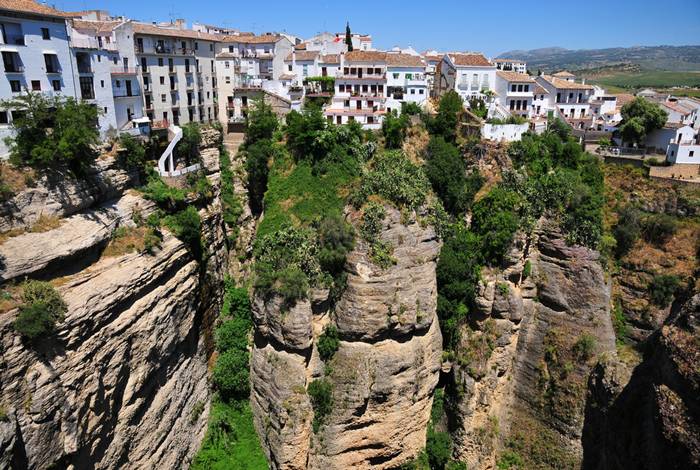The Beauty of Cliffside City of Ronda — Spain 
Ronda
is a city in the Spanish province of Málaga. It is located about 100
kilometres (62 mi) west of the city of Málaga with a population of
approximately 35,000 inhabitants. Ronda was first settled by the early
Celts, who, in the 6th century BC, called it Arunda. Later Phoenician
settlers established themselves nearby to found Acinipo, known locally
as Ronda la Vieja, Arunda or Old Ronda. The current Ronda is however of
Roman origins, having been founded as a fortified post in the Second
Punic War, by Scipio Africanus. Ronda received the title of city at the
time of Julius Caesar. The city is situated in a very mountainous area
about 750 meters (2,460 ft) above mean sea level. The Guadalevin River
runs through the city, dividing it in two and carving out the steep, 100
plus meters deep El Tajo canyon upon which the city perches. Three
bridges, Puente Romano, Puente Viejo and Puente Nuevo, span the canyon.
Photo — Link
The Beauty of Cliffside City of Ronda — Spain
Photo — Link
The Beauty of Cliffside City of Ronda — Spain
Photo — Link
The Beauty of Cliffside City of Ronda — Spain
Photo — Link
The Beauty of Cliffside City of Ronda — Spain
Photo — Link
The Beauty of Cliffside City of Ronda — Spain
Photo — Link
The Beauty of Cliffside City of Ronda — Spain
Photo — Link
The Beauty of Cliffside City of Ronda — Spain
Photo — Link
The Beauty of Cliffside City of Ronda — Spain
Photo — Link
The Beauty of Cliffside City of Ronda — Spain
Photo — Link
The Beauty of Cliffside City of Ronda — Spain
Photo — Link
The Beauty of Cliffside City of Ronda — Spain
Photo — Link
The Beauty of Cliffside City of Ronda — Spain
Photo — Link
The Beauty of Cliffside City of Ronda — Spain
Photo — Link
The Beauty of Cliffside City of Ronda — Spain
Photo — Link
The Beauty of Cliffside City of Ronda — Spain
Photo — Link
The Beauty of Cliffside City of Ronda — Spain
Photo — Link
Via — Link

















No comments:
Post a Comment
Note: only a member of this blog may post a comment.